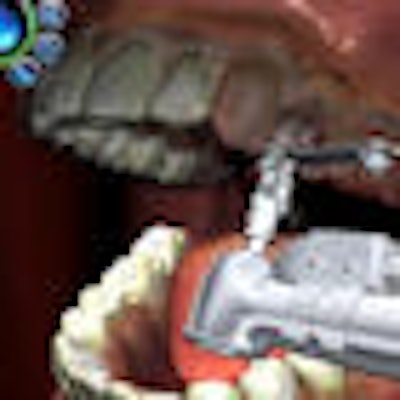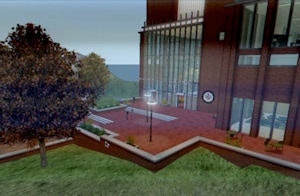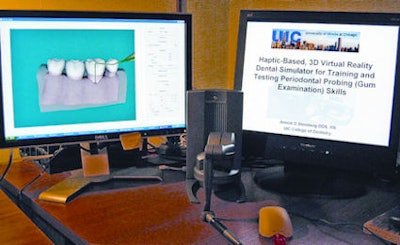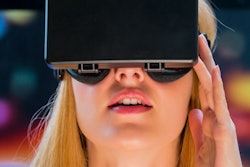
The handsome three-story, glass- and brick-walled building would look right at home on any college campus. Trees shade the walkways, and portraits of serious-looking school deans line the dark-paneled walls.
 |
| The three-story, glass- and brick-walled building featured in the University of Maryland's Second Life simulation program would look right at home on any college campus. Image courtesy of the University of Maryland, Baltimore. |
For the past year, instructors at UMB have been using the 3D online world to help supplement live classroom teaching and hone students' dental skills. Students and instructors can log onto the site, create avatars (3D representations of themselves), and simulate real-world scenarios, said Carroll-Ann Trotman, B.D.S., M.A., M.S., associate dean for academic affairs.
So far, the school has not used Second Life to teach hands-on dentistry, but the program has proved extremely useful for role playing, Dr. Trotman said. To practice certain dentist-patient interactions, for example, students pair up, with each one taking turns playing the patient and doctor.
"The exercise might be to greet the patient, take them back to the operatory, make them feel comfortable, and take their health history," she said. "To do that in real life, you have to be in school during certain hours and find a clinical area that's available. With 130 students all needing to do this, that can be difficult. But in Second Life, they can do it whenever they want, wherever they want. The instructor can be there as they do it, or he/she can view the interaction later and critique it."
Instructors can also use Second Life to present lectures, incorporating the same videos and other streaming media they'd use in a real-world lecture. These talks can also be recorded and viewed online without needing to visit Second Life.
Using space in the virtual world helps to free up valuable space in the real world, added Julie Gilliam, an instructional technology specialist for the school, who oversaw the creation of the university's virtual classrooms.
"You don't often get to view yourself doing something in real life," Gilliam said. "In addition to inhabiting your avatar in Second Life, you also get to watch yourself doing things. It gives you a perspective on your own behavior you wouldn't otherwise get."
PerioSim
Online worlds are only one way dental schools are using the latest in computer technology to revolutionize dental education. At the University of Illinois at Chicago (UIC), novice dental and hygiene students can feel for calculi on the roots of teeth, measure pocket depth, and probe for periodontic abnormalities without touching an actual mouth. Jointly developed by UIC's dentistry and engineering colleges, the 3D PerioSim program allows UIC students to simulate periodontal examinations.
 |
| At the University of Illinois at Chicago, dental students use the 3D PerioSim program to feel for calculi on the roots of teeth, measure pocket depth, and probe for periodontic abnormalities without touching an actual mouth. Image courtesy of University of Illinois at Chicago. |
"Students can view the models from virtually any angle or level of transparency, completely or partially add or remove any of the anatomical elements of the quadrant, feel the instrument pressure on teeth or any of the tissues, record the exam, and play it back later," said Arnold Steinberg, D.D.S., M.S., a professor of periodontics and biochemistry at UIC.
They can even access the simulator via the Internet and run it as often as they like -- without making more demands on school faculty or requiring more sessions with practice patients. PerioSim also allows instructors to guide students through an exam; the instructor controls the movements of the explorer, while the student literally (albeit remotely) gets a feel for the procedure.
In 2007, an evaluation of the PerioSim by 30 UIC dental school faculty members gave the system high marks for making teeth and instruments look and feel realistic, but mediocre scores for simulating gingiva (Journal of Dental Education, December 2007, Vol. 71: 12, pp. 1574-1582). However, the current version of the software improves markedly on those initial results, according to Dr. Steinberg.
"We are now evaluating our belief that this system will provide novice dentists and hygienists with a faster way to learn early caries and/or periodontal disease detection than traditional training in an overloaded curriculum," he said.
Virtual implants
More recently, the Medical College of Georgia (MCG) debuted the Virtual Dental Implant Training Simulation Program, designed to help students in diagnostics, decision-making, and treatment protocols. It was designed by MCG School of Dentistry faculty and students and BreakAway, a developer of game-based technology for training, experimentation, and decision-making analysis. The program uses the Pulse Virtual Clinical Learning Lab developed by BreakAway in partnership with Texas A&M University-Corpus Christi.
"There's a lot of enthusiasm in the global dental and medical communities to use virtual reality and simulation as a tool to convey and reinforce information and ensure competency levels," said Roman Cibirka, D.D.S., vice president for instruction and enrollment management and the program's project director.
 |
| In the Virtual Dental Implant Training Program, if the virtual patient is a candidate for implant therapy, students decide the type, location, and orientation of the implants; type and location of anesthesia; and tools for surgery. Image courtesy of the Medical College of Georgia. |
"It's realistic. If the student doesn't place anesthesia in the right spot, the patient screams," Dr. Cibirka said. But it is intended to supplement, not replace, clinical training, he noted.
"It's anytime, anywhere education -- a classroom without walls," Dr. Cibirka said. "I think it really fortifies the entire educational experience and capitalizes on the needs of this generation."
The program is now being evaluated for functionality and instructional usefulness by more than 20 dental schools in the Nobel Biocare University Partnership Program. This summer it will be launched at 25 universities worldwide, potentially reaching 15,000 dental students, Dr. Cibirka said.
Real 3D
But some dental educators remain wary of simulation tools. John Carl McManama, D.D.S., a professor of general dentistry at the Boston University Henry M. Goldman School of Dental Medicine. Dr. McManama has evaluated several virtual reality simulators over the years but never found one he thought was worth using, he said.
Thus the simulators at the school's Simulation Learning Center are literally 3D. The center comprises 115 fully stocked dental operatories with "permanent patients" -- the heads and necks of mannequins that look not unlike the heads of crash test dummies. Students use the mannequins' removable jaws and teeth to perfect their drill-and-fill skills. To simulate tooth decay, they place wax on the surface of the teeth.
"We make up a story for every patient -- 'Hi, this is Joe. He has a cavity on the front of tooth 30.' -- and run every session as if it were a regular session with a normal patient," Dr. McManama said.
Even then some things are impossible to simulate, he noted. "The sims don't bleed or complain, and they don't have tongues or saliva. Students can't be taught to extract a tooth, and obviously the wax we use isn't much like actual tooth decay. But I do as much as I can to make my students think of the simulators as human beings with real feelings. About 50% of the skills students need to develop are trainable on our simulators."
Dental schools with high-tech tools
|
Dan Tynan writes about technology (and occasionally teeth) for a wide range of publications.
Copyright © 2009 DrBicuspid.com



















